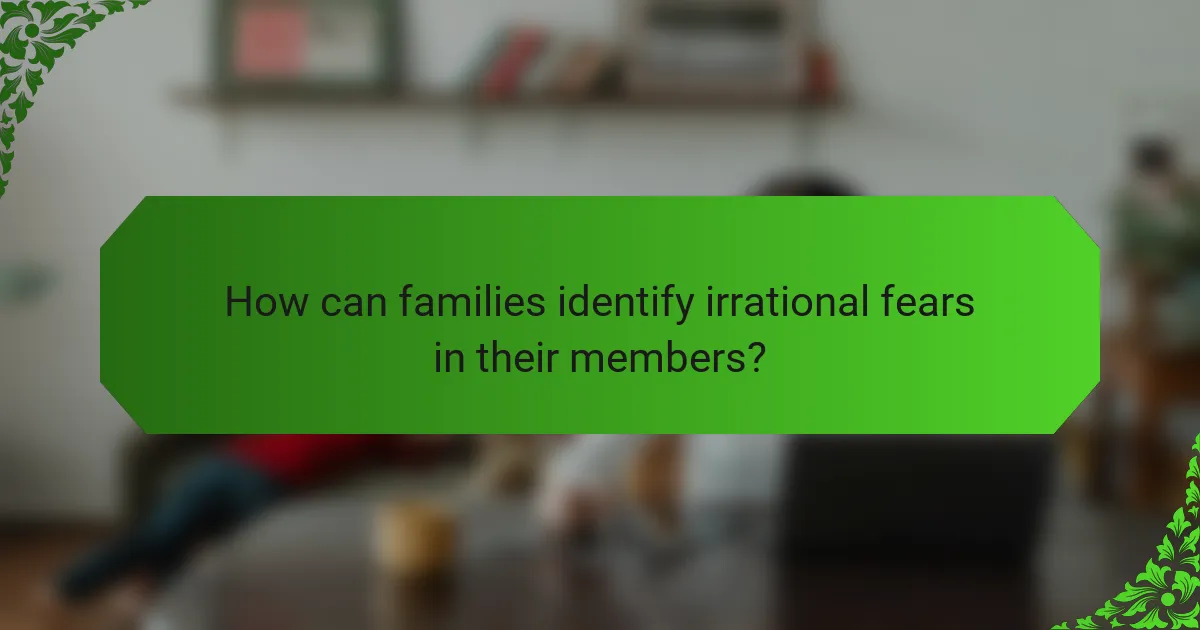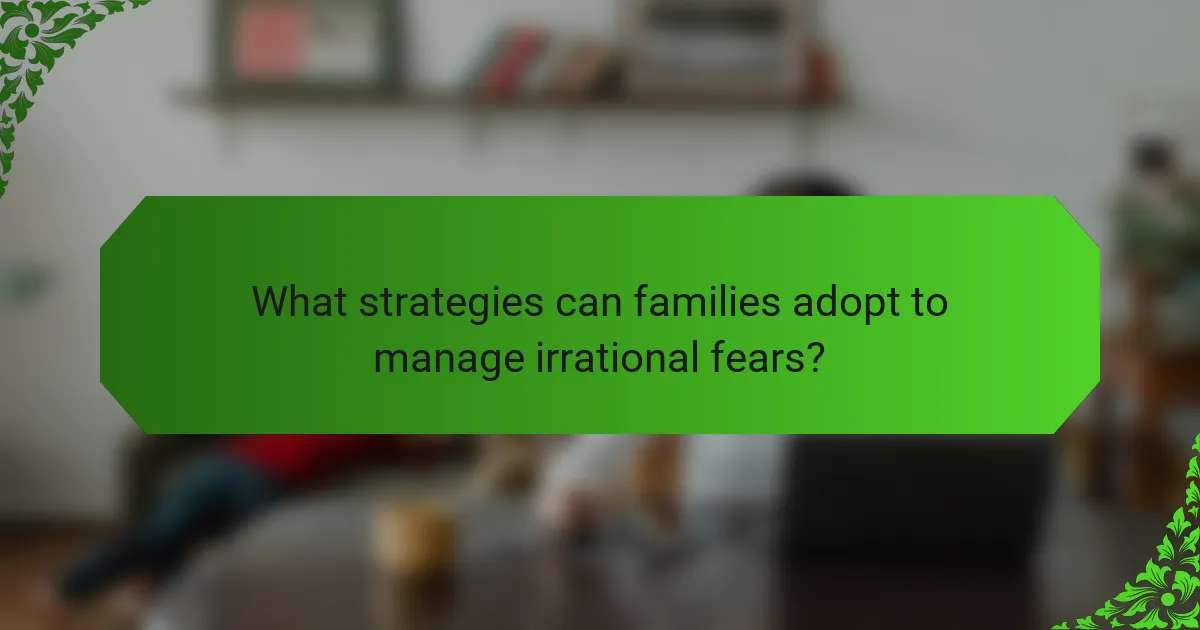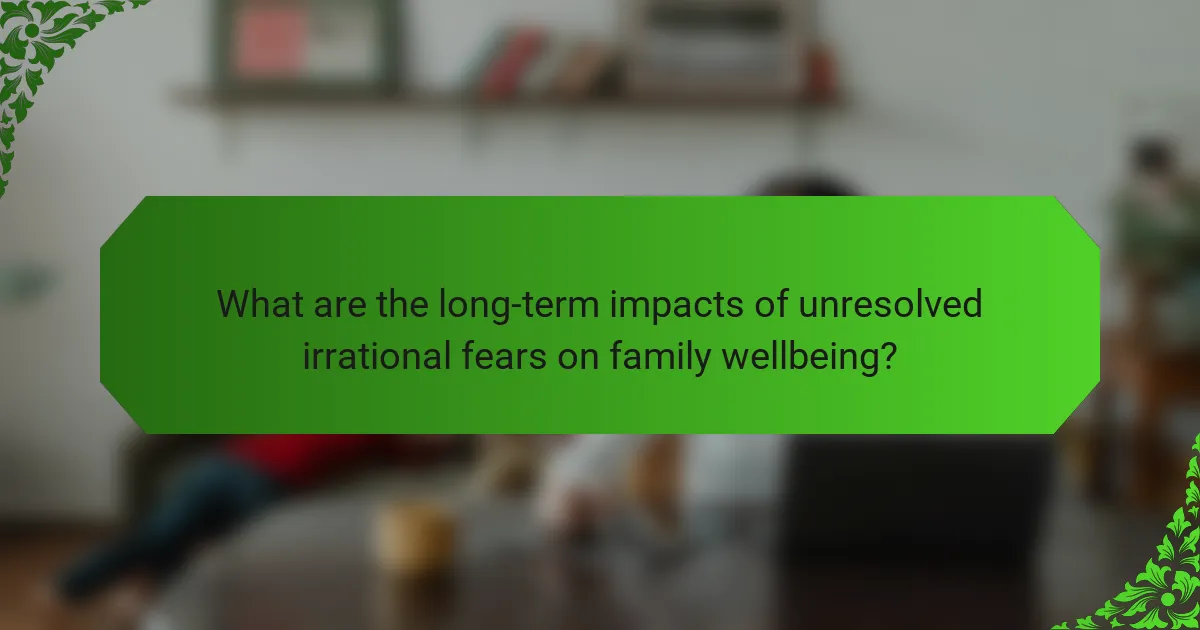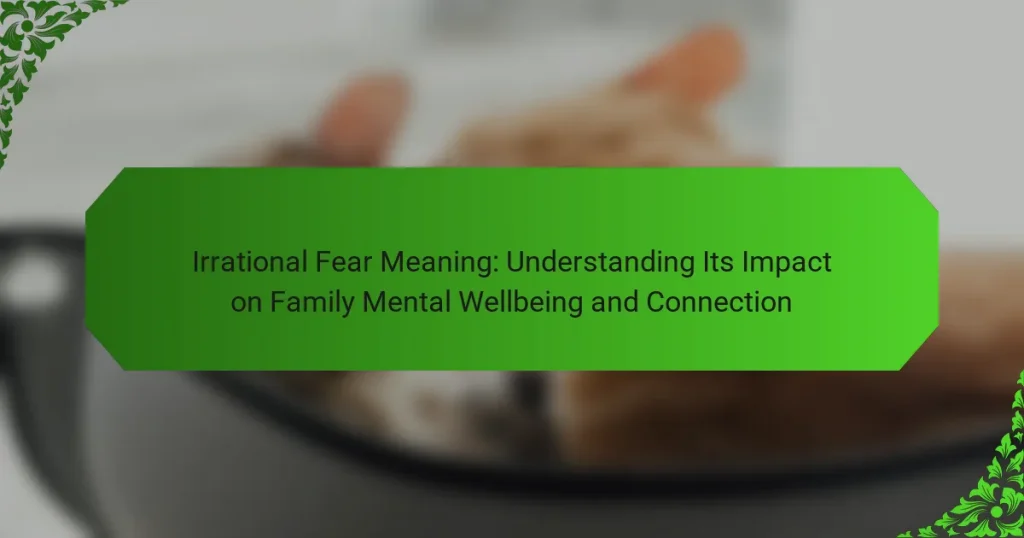Irrational fear can disrupt family dynamics and impact mental wellbeing. This article explores its definition, manifestations, unique attributes, and effects on family relationships. It also discusses strategies for managing these fears and fostering a supportive environment. Understanding and addressing irrational fears is essential for enhancing family connections and overall mental health.

What is the meaning of irrational fear?
Irrational fear refers to intense, disproportionate anxiety about specific situations or objects that often disrupt daily life. This type of fear can significantly impact family mental wellbeing, leading to strained relationships and decreased emotional connection. Understanding these fears allows families to address underlying issues, fostering a supportive environment that enhances overall mental health. Engaging in open discussions and seeking professional help can mitigate the effects of irrational fears, ultimately strengthening familial bonds.
How do irrational fears develop within families?
Irrational fears often develop within families due to learned behaviors and environmental influences. Children observe and mimic the fears exhibited by parents or siblings, creating a cycle of anxiety. Factors such as overprotectiveness, trauma, and communication patterns contribute significantly to this dynamic. As a result, these fears can disrupt family mental wellbeing and hinder connections. Understanding these influences is crucial for addressing irrational fears effectively.
What role does childhood experience play in shaping irrational fears?
Childhood experiences significantly influence the development of irrational fears. Early interactions, parental responses, and environmental factors shape perceptions of safety and threat. For example, children exposed to overprotective parenting may develop fears that persist into adulthood. Research indicates that approximately 60% of individuals with irrational fears report having negative childhood experiences linked to those fears. Understanding these connections is essential for addressing family mental wellbeing and fostering healthier emotional responses.

What are the universal attributes of irrational fear?
Irrational fear universally manifests through heightened anxiety, avoidance behavior, and distorted perceptions. These attributes impact family mental wellbeing by creating tension, misunderstanding, and isolation among members. Research indicates that irrational fears can disrupt communication and emotional connections, leading to a decline in overall family dynamics. Addressing these fears collectively can foster resilience and strengthen relationships.
How does irrational fear manifest in daily family life?
Irrational fear can disrupt daily family life by causing anxiety and tension among members. It may manifest through avoidance behaviors, such as refusing to engage in social activities or limiting interactions with certain people. This can lead to isolation and hinder family bonding, impacting overall mental wellbeing. As a result, communication may break down, creating misunderstandings and conflicts. Families may experience a unique attribute of decreased emotional support, as members struggle to understand or validate each other’s fears. Addressing these fears through open dialogue and professional guidance can help restore connection and improve family dynamics.
What common triggers lead to irrational fears in family members?
Common triggers for irrational fears in family members include past traumatic experiences, significant life changes, and environmental stressors. These factors can lead to heightened anxiety and fear responses. Understanding these triggers is essential for addressing and mitigating their impact on family mental wellbeing. For example, a child may develop a fear of dogs after being bitten, while an adult may experience anxiety during transitions like moving or job loss. Recognizing these patterns fosters better communication and support within the family unit.
How do irrational fears affect family communication?
Irrational fears can significantly hinder family communication by creating misunderstandings and emotional distance. These fears often lead to avoidance behaviors, where family members hesitate to discuss their feelings or concerns. As a result, open dialogue diminishes, impacting overall family mental wellbeing. Families may experience increased tension and conflict as irrational fears go unaddressed, leading to a breakdown in connection. Addressing these fears through open communication can foster understanding and strengthen familial bonds.

What unique attributes differentiate irrational fears in family contexts?
Irrational fears in family contexts are often differentiated by their unique attributes, such as intensity, triggers, and emotional responses. These fears can manifest in varying degrees, affecting family dynamics and mental wellbeing. For instance, a child’s irrational fear of the dark may evoke different responses from parents compared to an adult’s fear of social situations. The intensity of these fears can create unique challenges in communication and connection within the family unit. Understanding these attributes is crucial for addressing the underlying issues and fostering a supportive environment.
How does cultural background influence irrational fears?
Cultural background significantly influences irrational fears by shaping perceptions and responses. Different cultures have unique narratives around fear, affecting mental wellbeing and family connections. For example, collectivist cultures may emphasize communal fears, while individualistic cultures focus on personal anxieties. This cultural lens can determine how families address and manage these fears, impacting their emotional support systems and overall resilience.
What unique coping mechanisms do families employ for irrational fears?
Families utilize unique coping mechanisms for irrational fears, such as open communication, creative expression, and structured routines. Open dialogue fosters understanding and reduces stigma around fears. Creative outlets, like art or writing, allow family members to express emotions non-verbally. Structured routines provide stability, helping to manage anxiety. Additionally, shared activities can strengthen family bonds, promoting resilience against irrational fears. These strategies enhance mental wellbeing and foster deeper connections within families.

What rare attributes are associated with irrational fear?
Irrational fears can exhibit rare attributes such as sudden onset, disproportionate response to triggers, and a tendency to persist despite rational explanations. These characteristics can lead to significant disruptions in family dynamics and individual mental health. Understanding these attributes is crucial for addressing their impact on mental wellbeing and fostering stronger family connections.
How do specific irrational fears impact family dynamics?
Irrational fears can significantly disrupt family dynamics by creating tension and misunderstanding. These fears may lead to avoidance behaviors, limiting family interactions and shared experiences. For instance, a family member with a fear of flying may miss vacations, causing resentment. Additionally, irrational fears can strain communication, as family members may struggle to express their concerns or support effectively. This can result in feelings of isolation among those affected. Ultimately, addressing these fears collectively fosters understanding and strengthens family bonds.
What are the less common symptoms of irrational fear in families?
Less common symptoms of irrational fear in families include unexplained physical symptoms, avoidance behaviors, emotional numbness, and excessive reassurance-seeking. These manifestations often disrupt family dynamics and mental wellbeing, indicating deeper psychological issues. Understanding these symptoms can help families address fears effectively and strengthen connections.

How can families identify irrational fears in their members?
Families can identify irrational fears by observing behaviors and emotional responses. Look for signs like avoidance of certain situations, excessive worry, or physical symptoms such as trembling. Engaging in open discussions helps members express their fears, fostering understanding and connection. Recognizing these patterns enhances family mental wellbeing.
What signs indicate that a fear is irrational?
Irrational fears often manifest through intense anxiety disproportionate to the actual threat. Signs include avoidance behavior, persistent worry, and physical symptoms like sweating. These reactions can disrupt family dynamics and mental well-being. Recognizing these signs is vital for fostering healthy connections and addressing underlying issues.
How can open discussions help in recognizing irrational fears?
Open discussions can significantly aid in recognizing irrational fears by fostering a safe environment for expression. This approach encourages individuals to articulate their concerns, helping to identify patterns and triggers associated with their fears. As a result, families can better understand the emotional impact of these fears on mental wellbeing and strengthen their connections. Engaging in dialogue not only normalizes these fears but also promotes empathy and support, ultimately leading to more effective coping strategies.

What strategies can families adopt to manage irrational fears?
Families can manage irrational fears by fostering open communication, creating a supportive environment, and employing coping strategies. Encouraging discussions about fears helps normalize them and reduces stigma. Establishing routines can provide stability and comfort. Techniques such as deep breathing, visualization, or gradual exposure to fears can empower family members to confront their anxieties. Engaging in family activities that promote bonding and relaxation can further strengthen connections and enhance overall mental wellbeing.
What role does therapy play in addressing irrational fears?
Therapy plays a crucial role in addressing irrational fears by providing effective coping strategies and emotional support. It helps individuals identify the root causes of their fears, enabling them to understand and reframe their thoughts. Cognitive Behavioral Therapy (CBT) is particularly beneficial, as it focuses on changing negative thought patterns and behaviors associated with irrational fears. Through therapy, individuals can develop resilience, improve family mental wellbeing, and foster stronger connections within their families. This process often leads to enhanced communication and understanding, ultimately reducing the impact of irrational fears on family dynamics.
How can families create a supportive environment for discussing fears?
Families can create a supportive environment for discussing fears by fostering open communication. Encourage family members to share their feelings without judgment. Establish regular family meetings to discuss emotions and fears, ensuring everyone feels heard. Validate each other’s feelings as a crucial step in promoting mental wellbeing. Active listening strengthens connections and builds trust. Creating a safe space allows irrational fears to be addressed constructively, enhancing overall family dynamics.
What are effective communication techniques for families?
Effective communication techniques for families include active listening, open-ended questions, and non-verbal cues. These techniques foster understanding and connection. Active listening encourages family members to express feelings without interruption, promoting empathy. Open-ended questions stimulate deeper conversations, allowing individuals to share thoughts and experiences. Non-verbal cues, such as eye contact and body language, enhance emotional connection and demonstrate attentiveness. Implementing these techniques can significantly improve family dynamics and mental wellbeing.
What practical exercises can families do together to overcome irrational fears?
Families can engage in practical exercises like open discussions, role-playing, and exposure therapy to overcome irrational fears. These activities foster communication and strengthen family bonds while addressing fears constructively.
1. Open Discussions: Encourage family members to share their fears in a safe environment, promoting understanding and empathy.
2. Role-Playing: Act out scenarios involving fears to desensitize individuals and provide coping strategies.
3. Exposure Therapy: Gradually introduce feared situations in a controlled manner, helping family members confront and manage their fears together.
4. Creative Expression: Use art, music, or writing to express and explore fears, facilitating emotional release and connection.

What are the long-term impacts of unresolved irrational fears on family wellbeing?
Unresolved irrational fears can significantly harm family wellbeing over time. These fears often lead to anxiety, strained relationships, and reduced communication within the family unit. Families may experience increased tension as members struggle to cope with the irrational fears of one individual, creating an environment of stress and misunderstanding.
As a result, children may develop their own mental health issues, such as anxiety or depression, stemming from the unresolved fears of their parents. This cycle can perpetuate through generations, affecting family dynamics and emotional connections.
Moreover, families may find it challenging to engage in activities together, limiting opportunities for bonding and shared experiences. The emotional distance created by irrational fears can lead to feelings of isolation and resentment among family members.
Ultimately, addressing and resolving irrational fears is essential for fostering a supportive family environment and enhancing overall mental wellbeing.
How can unresolved fears affect children’s mental health?
Unresolved fears can significantly impact children’s mental health, leading to anxiety, depression, and social withdrawal. These fears often disrupt family dynamics and hinder emotional connections. For instance, children may avoid situations that trigger their fears, isolating themselves from peers and family activities. This isolation can exacerbate feelings of loneliness and helplessness. As a result, the entire family’s mental wellbeing can be strained, creating a cycle of distress that affects everyone involved. Addressing these fears early can foster healthier emotional development and strengthen family bonds.
What strategies can help families prevent the escalation of irrational fears?
Families can prevent the escalation of irrational fears by fostering open communication, promoting emotional awareness, and implementing gradual exposure techniques. Encouraging discussions about fears helps normalize feelings and reduces stigma. Teaching family members to identify and express emotions can enhance understanding and support. Gradual exposure, where individuals face fears in small, manageable steps, can diminish anxiety over time. Additionally, creating a supportive environment where fears are acknowledged can strengthen family bonds and promote mental wellbeing.

What are the best practices for fostering holistic mental wellbeing in families?
To foster holistic mental wellbeing in families, prioritize open communication, emotional support, and shared activities. Encourage family members to express their feelings and listen actively. Establish routines that include quality time together, promoting connection and understanding. Incorporate mindfulness practices, such as meditation or yoga, to reduce stress and enhance emotional resilience. Recognize the impact of irrational fear on family dynamics; addressing these fears collectively can strengthen bonds and improve overall mental health.
How can mindfulness and emotional regulation techniques help?
Mindfulness and emotional regulation techniques can significantly reduce irrational fear, enhancing family mental wellbeing. These practices foster awareness and control over emotions, leading to healthier communication and connection within families. Mindfulness helps individuals recognize fear triggers, while emotional regulation techniques provide tools to manage responses effectively. As a result, families experience improved relationships and resilience against anxiety.
What common mistakes should families avoid when addressing irrational fears?
Families should avoid minimizing fears, dismissing emotions, using negative reinforcement, and failing to communicate openly. These mistakes can exacerbate irrational fears and hinder mental wellbeing. Acknowledging fears fosters connection and understanding, essential for family support.
How can families seek expert insights for better understanding and managing fears?
Families can seek expert insights through therapy, workshops, and educational resources. Engaging with mental health professionals helps in understanding irrational fears and their effects on family dynamics. Experts provide tailored strategies to manage these fears, fostering better mental wellbeing and connection. Family therapy sessions can create a safe space for discussing fears, while workshops offer tools for coping and communication. Accessing literature on irrational fears can also enhance understanding and provide practical advice for families.




